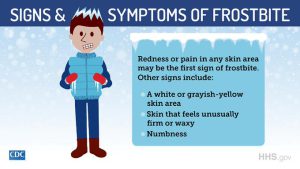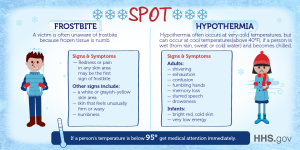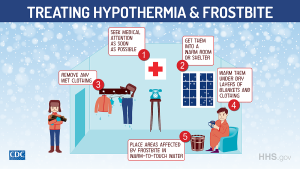Stay Safe in Winter Weather
Posted on byNote: The below vignette is a fictional account showing possible health risks from exposure to cold weather.
Matthew is outside on a cold, winter day shoveling snow out of his driveway. He starts to shiver and feel drowsy, but he decides to keep working until he finishes.
When his neighbor Anna passes by, she notices something is wrong. Matthew seems confused and doesn’t recognize her. He tries to say something, but his speech is slurred. His hands fumble as he grips the shovel. Anna recognizes that these could be signs of hypothermia, a medical emergency.
Anna acts quickly, bringing Matthew inside a heated home and covering him with dry blankets. She calls 911 and warms a cup of hot water for him while they wait for help.
Across the street, a child named Sarah is playing outside. Sarah is building a snowman without wearing gloves and hasn’t noticed that her fingers have become numb. When her father comes outside, he sees Sarah’s fingers have turned white—a sign of frostbite.
Sarah’s father brings Sarah inside the house and places her hands in a lukewarm bowl of water. He also instructs Sarah not to rub or massage her fingers, which could cause more damage.
In these scenarios, knowledge of cold weather safety saved Matthew and Sarah from dangerous situations. As the winter season begins, it’s important to know how to prevent and treat hypothermia and frostbite.
Prepare Ahead and Help Others
One of the best ways to stay safe in cold weather is to prepare ahead of time. Avoid going outside in extremely cold weather for long periods of time. If you must go outside, dress warmly with a hat, scarf, mittens or gloves, water-resistant coat and boots, dry socks, and several layers of clothing. Stay dry—wet clothing chills the body quickly.
It’s important to also watch out for the health and safety of others, including older adults and babies, who are at high risk when exposed to cold temperatures. People often don’t realize they have hypothermia or frostbite. If you notice someone with symptoms of these conditions, get immediate medical help.
Hypothermia

When someone loses body heat faster than they produce it, they could experience hypothermia. Hypothermia affects the brain’s ability to function, making it difficult to think and act normally.
Signs of hypothermia include shivering, tiredness, confusion, fumbling hands, memory loss, slurred speech, and drowsiness. Babies experiencing hypothermia could experience bright red skin*, cold skin, and low energy. In severe cases, hypothermia could lead to death.
Know how to help someone experiencing hypothermia:
- Seek immediate medical attention. Hypothermia is a medical emergency! If someone has a body temperature below 95°F, call 911 or bring the person to the nearest hospital. If you are not able to get medical help right away, try to warm the person up.
- Warm the person. If possible, move the person into a heated building while you wait for help. Focus on warming the person’s chest, neck, head, and groin.
- Replace wet clothing with dry layers. Remove wet clothing, which can make hypothermia worse. Cover the person with dry clothing, towels, sheets, or an electric blanket.
- Provide the person with warm water. Warm, non-alcoholic beverages can raise the person’s body temperature if they can safely drink. If the person is unconscious, do NOT give them fluids.
- Perform CPR if necessary. Severe cases of hypothermia could lead to unconsciousness, stopped breathing, and loss of a pulse. If the person shows these symptoms, perform CPR until the person becomes responsive or medical help arrives.
Frostbite

Exposure to cold weather can also cause frostbite, an injury that can permanently damage the body. The nose, ears, cheeks, chin, fingers, and toes are especially vulnerable to frostbite.
Early symptoms of frostbite include skin redness or pain. As frostbite progresses, the affected skin may become white or grayish in color*, unusually firm or waxy, and numb. In severe cases, body parts affected by frostbite may need to be removed.
Know how to help someone experiencing frostbite:
- Get urgent medical care. Call 911 or bring the person experiencing frostbite to the nearest hospital. Also check the person for signs of hypothermia, which could be life-threatening.
- Warm the affected area. Move the person into a warm shelter if possible. Gently warm the affected area using body heat or warm (not hot) water.
- DON’T put pressure on the affected area. Do not rub or massage the frostbitten area. Avoid walking on feet or toes that show signs of frostbite. Applying pressure could increase damage.
- Stay at a safe distance from heat sources. Frostbitten areas burn easily, so don’t let the person get too close to heating pads, heat lamps, stoves, fireplaces, or radiators.
*Note: Skin color changes may be less apparent in people with darker skin tones.
Additional Resources
- Preparing for a winter storm
- Stay safe and healthy in winter
- Infographic: Be ready for winter weather
- Older adults and extreme cold
- Children’s activity book: Ready Wrigley Prepares for Winter Weather
- Cold weather and traveler’s health
Tweets

Tweet this: Can you recognize signs of #frostbite and #hypothermia? One of the best ways to prepare for #WinterWeather is to be informed! Learn more about these conditions and how to treat them by reading @CDCgov’s latest #CDCEHblog: https://bit.ly/3HZ6IDg

Tweet this: Stay safe in cold weather! The #CDCEHblog has important information on protecting yourself and others from #frostbite and #hypothermia: https://bit.ly/3HZ6IDg #WinterWeather
Post a Comment